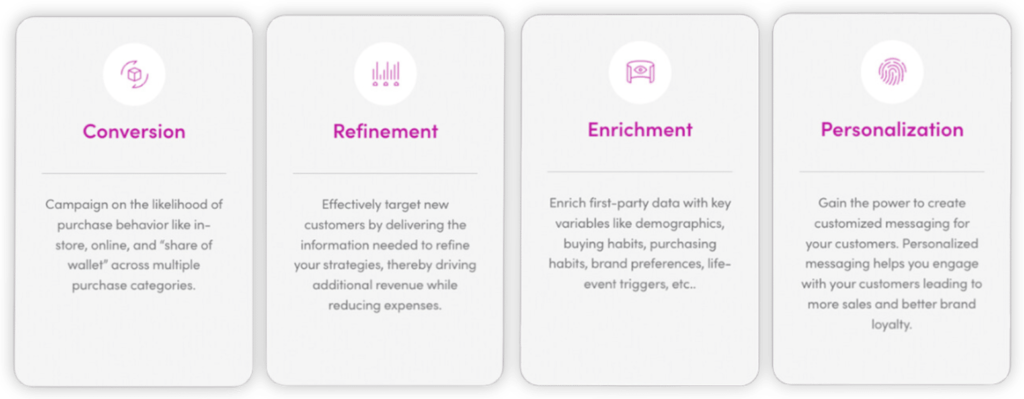We live in the era of Big Data – and it’s a Big Deal. Thanks to huge advancements in computing power, humans are creating, consuming, and capturing data at an exponential rate. According to Statista research and predictions, we generate nearly 294 billion emails and 720,000 hours of YouTube content daily and are on track to create, capture, and consume upwards of 180 zettabytes of data in 2025.
This is an incredible quantity of data that’s ripe for brand picking! And while businesses now understand how to capture and store this valuable human-generated data, many do not know how to make sense of it.
If you need a new way to connect with your audience and have been wondering what to do with the vast amount of data and marketing research lying dormant in core storage, you need a step-by-step guide to turn that information into effective storytelling in marketing.
Turning Data into Brand Narratives
No matter the industry or size, every brand faces a common challenge: turning cold, hard data into a lively, intriguing story that connects with consumers. Compiling vast amounts of data and then analyzing and interpreting it to form a narrative may feel like a new concept, but this process actually dates to the first century AD. Ancient books were created to record valuable information of past civilizations, but they evolved into the beautiful storytelling medium we know today. By applying this strategy to modern marketing practices, brands can use their vast quantities of consumer data to create winning narratives that resonate more deeply with target audiences.
If your brand is housing more data than you know what to do with, consider putting this valuable information to work. Create branded stories that increase your consumer awareness, build brand loyalty and trust, and ultimately capture lifelong customers that help your business scale. Let’s examine three critical ways you can start mining data for key insights that can help your brand develop a compelling brand story.
1. Look for the white space
White space consists of the untapped segments of your brand’s potential. Finding and addressing your brand’s white space is a proven method of applying data and marketing research to create effective storytelling in marketing. Your brand’s white space includes all potential product lines, services, and value propositions not yet addressed by your current marketing strategy.
You can find your white space by surveying your current offerings and your industry. Identify gaps in your product lines that could serve a broader, or a hyper-focused, segment of your target audience. What is missing from your line that could address an important consumer need or want? Where are the glaring market gaps that your brand might be able to fill? That massive quantity of marketing research data can now be put to good use! Mine your data storage to answer these important questions and turn your digital data points into a targeted brand narrative.
Another great way to apply the white space model to your marketing research is to consider how consumers are using your current products in unexpected ways. YouTube is full of DIY videos that take basic IKEA products and repurpose them into highly functional items; by proactively seeking out white space opportunities, your brand can develop creative new ways to satisfy customer needs. Use your stored data to find gaps in your product or service line and then fill those spaces with useful solutions.
2. Listen to your audience
Social listening is the process of gathering brand mentions from multiple social media channels. It includes gleaning information from online customer feedback and comments on your brand’s social media posts…but its insights do not stop there. When properly leveraged, social listening allows you to assess your brand’s health, gain industry insights, identify trends, and determine your brand’s share of the market. Social listening is a tool that shows you exactly how your brand is working – or not working – for your customers.
Marketing research gathered from social listening enables you to learn how your customers perceive your brand and products, as well as how they feel about your competition. Are people expressing frustrations you could help them solve? Tap into social listening data to identify pain points that your brand can address, then use that information to further develop your brand story. Are consumers taking to social media to complain about your competitor’s long wait times? Create branded content about your new app that makes it easy to order ahead! Are people annoyed with competitors’ sub-par product quality? Use your ad spend to tout your superior craftsmanship.
You might also examine the way your competitors listen to their audiences. Where are they spending the majority of their advertising dollars? Which audience demographics are they speaking to with their brand messaging, and what are they saying? For example, if your competitors are leaning into efficiency claims, talk up your brand’s proven quality and durability. Are you up against global spirits brands paying top-dollar for ad spots on sports networks? Consider playing to your audience’s passion for action with similarly thrilling but considerably less expensive ad spots on travel networks. You may not be able to outspend every competing brand in your market segment, but you can certainly outsmart them. By examining competitive data and identifying overlooked audiences or features, you can create more effective branded storytelling.
3. Connect the dots
As technological advancements bring more and more data points to the surface and allow companies to drill down into granular marketing research, Big Data can start to feel like Overwhelming Data – kind of like opening a 10,000-piece puzzle with no idea what the final image is supposed to look like. But this is a challenge your brand can overcome. Technology is piling on the data, and technology can help you arrange it all into a complete, cohesive picture of your consumers and their behaviors.
While multiple platforms exist that can help your brand identify white space in your product lines or capture social listening data, there was still a gap in the market – (human)x found it and filled it. Your brand, like many others, might have a plethora of marketing research data gathering dust on a cloud server, but none of that matters if you can’t transform your informational goldmine into an actionable marketing strategy. At (human)x, we identified this white space through our own comprehensive market research and stepped up to give our clients what they truly need: humanView™. humanView™ is (human)x’s own proprietary predictive modeling software that enables us to know, understand, and market to the humans we’re talking to. With its predictive modeling capabilities, we can then craft the right narratives, on the right channels, at the right time to create more meaningful consumer connections.

The (human)x Data Solution
humanView™ is a powerful tool used to gain insights that can drive a brand narrative and truly connect with an audience. Our software enriches first-party data by incorporating new updates and information to improve accuracy and add missing information. In fact, humanView™ is capable of enriching first-person data with up to 1,000 different data points, including standard information such as age, occupation, and location, as well as more granular data like investment behaviors and philanthropic interests.
humanView™ creates a complete overview of each customer, allowing us to create unique profiles, build cohesive consumer journeys, accurately predict consumer behavior, personalize messaging, and increase likelihood of conversions. If your brand is struggling to make effective use of its overwhelming data points and needs a tool like humanView™ to help clarify the picture, request a consultation with the (human)x team. Our white space-filling software is already helping brands accurately predict which messages will connect with consumers and influence their purchasing behavior – and it can help you too.

